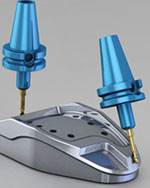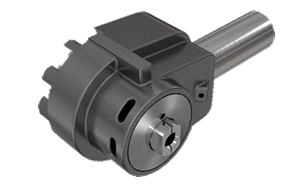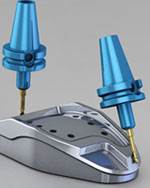High-Speed Machining Simplified
How high-speed machining can be reliably achieved by using the principles applied along with the correct tooling, feeds and speeds.
High-speed machining (HSM) is usually associated with high-speed spindles (15K to 40K rpm) and higher feedrates. It is also referred to as high velocity machining. They are one in the same, as both represent machining components in the most accurate and shortest cycle times. In the past 10 to 15 years HSM was focused on the mold and die industry that uses pre-hardened materials and hardened tool steels—such as P-20, H-13, S-7 and D-2, which range in hardness from 28-62 HRC. The traditional method of finish machining hardened materials was EDM. In applications where HSM can replace the EDM process there will be considerable cost and cycle time reductions.
To be successful with HSM the following components need to be integrated; if one of these is incorrectly applied then your machining application will suffer.
HSM Principles
Not everyone understands how and when to apply the correct HSM principles. This is not to say that every machining application will benefit from HSM, but many applications could if it weren’t for misinformation and assumptions. Figure 1 shows some of the components you need to consider when using HSM processes.
CNC Machine
This is the most significant component for HSM, and should be designed specifically for HSM. The construction of the base, as well as the individual components—drive train, spindle and CNC—must be capable of handling the demands of HSM, especially in the case of hard milling. It is much more than just looking at the maximum spindle rpm and feedrates. You must consider the size and mix of work to be machined. Know what you are planning to machine and evaluate accordingly. Are you going to be machining 2-D or 3-D surfaces on components or are materials to be machined, soft or hardened? These are just two examples.
Example
A machine is purchased with the highest spindle rpm available: 40K with 1,000 ipm feedrate. Sounds great, right? Let’s go further: all of your parts are very intricate and small, you have some of the best HSM cutting tools (1.0mm in Dia. / 2-Flute) designed for 60K rpm with a chip load of .003". Now you are limited by the 40K spindle, so you will have to run cutters at a reduced rpm of 40K. Calculate the feedrate (40K x 2x.003") and you have 240 ipm feedrate. Now we have 40K rpm and 240 ipm, so we’re really moving! Wait, remember the size and intricacy of the parts you will be running? What if you cannot reach the 240 ipm because of the part configuration? You must slow down the spindle speed to maintain the chip load of .003" due to the actual feedrate that can be attained when actually cutting. The point is, you can only go as fast as the slowest link will allow (machine, CNC control, toolholder, cutting tools).
Toolholders
There is no one toolholder type that will satisfy all applications: shrink fit, hydraulic, collet style, etc. They all have specific features that can be applied depending upon the application. The same goes for the spindle taper interface as there are specific features for HSK and CAT, which are inherently different. These need to be evaluated depending upon your machining requirements.
Balancing is very important, but not all tools need to be balanced! It depends on what is required of the toolholder. Balance considerations start at about 8K rpm. That does not mean you balance all toolholders that will be run at 8K, it means that is where you start to think about balancing.
For instance, if a tool is to be run at 9K rpm and used in a roughing application it very well may not need to be balanced. On the other hand, toolholders that will be used for finishing operations at speeds above 8K rpm may benefit from balancing. It all depends upon your requirements.
Cutting Tools
This is one area where companies try to cut corners because of the cost associated per piece, but there are more variables to consider—performance and better finishes, along with how long the tool will perform well in the cut. In some cases, you can throw commodity-type tools at an application, but you will have shorter and less consistent tool life, resulting in more downtime changing tools, etc. You need to know what is expected of the cutting tool—surface finish, material hardness and tool life requirements—so you can run lights out, unattended.
CAD/CAM Systems
There are still many CAD/CAM systems that do not have the capabilities to create toolpaths for HSM or hard milling routines easily. To be able to evaluate a system, you must understand what types of routines are required for HSM to attain the best results. Using experts in the field will reduce your learning curve considerably.
Summary
One can experience HSM principles even on older machining centers. These applications will not necessarily be optimal for HSM techniques—due to equipment and tooling limitations—but the fact is, HSM can still be applied and result in better cycle times.
For instance, on older equipment with traditional controls that are still using drip feed, did you know that if you strip a G-Code program (3-D sculptured surface) to its basic requirements you can in many cases double your feedrate reducing your cycle times by half? Take out all unnecessary characters like line numbers and redundant information and program incremental instead of absolute, and give it a try. Naturally, it depends on the specific machine used, but many can be increased from machining at 20-30 ipm to 60-70 ipm.
Speeds and feeds are always difficult when first applying HSM principles. Remember, it all boils down to your specific application—which includes the machine, control, toolholder and cutting tools, and they all have recommended parameters. One needs to gather all of the variables and then apply them in each specific application.
Related Content
The Trifecta of Competitive Toolmaking
Process, technology and people form the foundations of the business philosophy in place at Eifel Mold & Engineering.
Read More3D Printing Enables Better Coolant Delivery in Milling Operations
Just like 3D printing enabled conformal cooling channels in molds, additive manufacturing is now being used to optimize coolant delivery in cutting tools.
Read MorePredictive Manufacturing Moves Mold Builder into Advanced Medical Component Manufacturing
From a hot rod hobby, medical molds and shop performance to technology extremes, key relationships and a growth strategy, it’s obvious details matter at Eden Tool.
Read MoreThe Benefits of Hand Scraping
Accuracy and flatness are two benefits of hand scraping that help improve machine loop stiffness, workpiece surface finish and component geometry.
Read MoreRead Next
Making the Most of High-Speed Machining
High-speed machining can cut mold manufacturing time in half, but only if it’s executed with an eye to the special needs of the tools and the process.
Read MoreHow to Use Strategic Planning Tools, Data to Manage the Human Side of Business
Q&A with Marion Wells, MMT EAB member and founder of Human Asset Management.
Read MoreAre You a Moldmaker Considering 3D Printing? Consider the 3D Printing Workshop at NPE2024
Presentations will cover 3D printing for mold tooling, material innovation, product development, bridge production and full-scale, high-volume additive manufacturing.
Read More










_300x250 1.png;maxWidth=300;quality=90)

.png;maxWidth=300;quality=90)

.jpg;maxWidth=300;quality=90)










